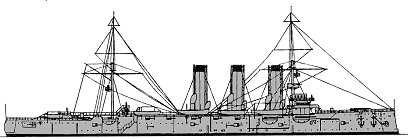
NAVYPEDIA
 Support the project with paypal
Support the project with paypal
Photo

Avrora
Ships
| Name | No | Yard No | Builder | Laid down | Launched | Comp | Fate |
|---|---|---|---|---|---|---|---|
| Паллада [Pallada] | Galernyy Is, St. Petersburg | 4.6.1897 | 26.8.1899 | 5.1901 | sunk 7.12.1904, to Japan (津軽 [Tsugaru]) | ||
| Диана [Diana] | Galernyy Is, St. Petersburg | 4.6.1897 | 12.10.1899 | 23.12.1901 | interned by France 8.1904-11/1905, sold 7.1922 | ||
| Аврора [Avrora] | New Admiralty, St. Petersburg | 4.6.1897 | 24.5.1900 | 29.7.1903 | interned by USA 6.1905-11/1905, TS 1939, damaged 30.9.1941, repaired as memorial 11.1948 |
Technical data
| Displacement normal, t | 6731 |
|---|---|
| Displacement full, t | Pallada: 6823 Diana: 6932 Avrora: 6897 |
| Length, m | 122.0 pp 123.5 wl 126.8 oa |
| Breadth, m | 16.8 |
| Draught, m | 6.35 - 6.55 max |
| No of shafts | 3 |
| Machinery | 3 VTE, 24 Belleville boilers |
| Power, h. p. | 11610 |
| Max speed, kts | 19.2 |
| Fuel, t | coal 972 |
| Endurance, nm(kts) | 3700(10) |
| Armour, mm | Pallada, Diana: Nickel steel: deck: 38 with 63mm slopes, glacises: 38, ammunition hoists: 38, CT: 152 Avrora: Nickel steel: shields: 25, deck: 38 with 63mm slopes, glacises: 38, ammunition hoists: 38, CT: 152 |
| Armament | 8 x 1 - 152/44 Canet, 24 x 1 - 75/48 Canet, 8 x 1 - 37/20 Hotchkiss, 3 - 381 TT (1 bow, 2 beam) |
| Complement | 570 |
Standard scale images

Diana 1904
Graphics
Project history
Protected cruisers, intending for reconnaissance service at squadron and actions on enemy`s trading routes. Three-funnelled cruisers with a forecastle deck as far as the mainmast. All three ships were sheathed and coppered. There was one 152mm gun forward on the forecastle deck, four in sponsons at upper deck level near the bridge and fore funnel, and three aft. The 75mm were on the main and upper decks.
Ship protection
Deck was 38mm in flat part and 63mm in slopes. CT had 152mm sides and 51mm roof. Engines were additionally protected by 38mm glacis.
Modernizations
1908, Avrora: - 4 x 1 - 75/48, 8 x 1 - 37/20, 3 - 381 TT; + 2 x 1 - 152/44 Canet, 126 mines
1913, Diana: - 4 x 1 - 75/48, 8 x 1 - 37/20; + 2 x 1 - 152/44 Canet, 126 mines
1914, Diana: - 10 x 1 - 152/44, 16 x 1 - 75/48, 3 - 381 TT; + 10 x 1 - 130/53
1916, Diana: - 4 x 1 - 75/48; + 2 x 1 - 75/48 Canet AA
1917, Avrora: - 20 x 1 - 75/48; + 4 x 1 - 152/44 Canet, 1 x 1 - 75/48 Canet AA
2/1923, Avrora: - 14 x 1 - 152/44, 1 x 1 - 75/48; + 10 x 1 - 130/53, 4 x 1 - 76/27 8K
1939, Avrora: - 1 x 1 - 130/53, 2 x 1 - 76/27; + 2 x 1 - 45/43 21K
Naval service
Pallada was sunk on shallow water by Japanese siege guns 7.12.1904 at Port Arthur and later destroyed by own crew 2.1.1905 to avoid capture by Japanese, but she was salvaged by them in July, repaired and commissioned as Tsugaru in 1907. Diana was interned by French authorities 24.8.1904 and returned to Russia after war in 1905, she was disarmed and broken up in 1922. Avrora was interned by American authorities 9.6.1905 and returned to Russia after war. She was laid up 5.1918 - 11.1922 and commissioned in 1922 as training cruiser. Avrora was disarmed in July 1941 and 30.9.1941 sunk on shallow water by German field guns. She was salvaged in July 1944 and preserved as memorial from 1948, in 1987 she was practically newly built and used as museum in St. Petersburg.
 HOME
HOME FIGHTING SHIPS OF THE WORLD
FIGHTING SHIPS OF THE WORLD RUSSIA / USSR
RUSSIA / USSR CRUISERS
CRUISERS PALLADA 1st class cruisers (1901 - 1903)
PALLADA 1st class cruisers (1901 - 1903)

